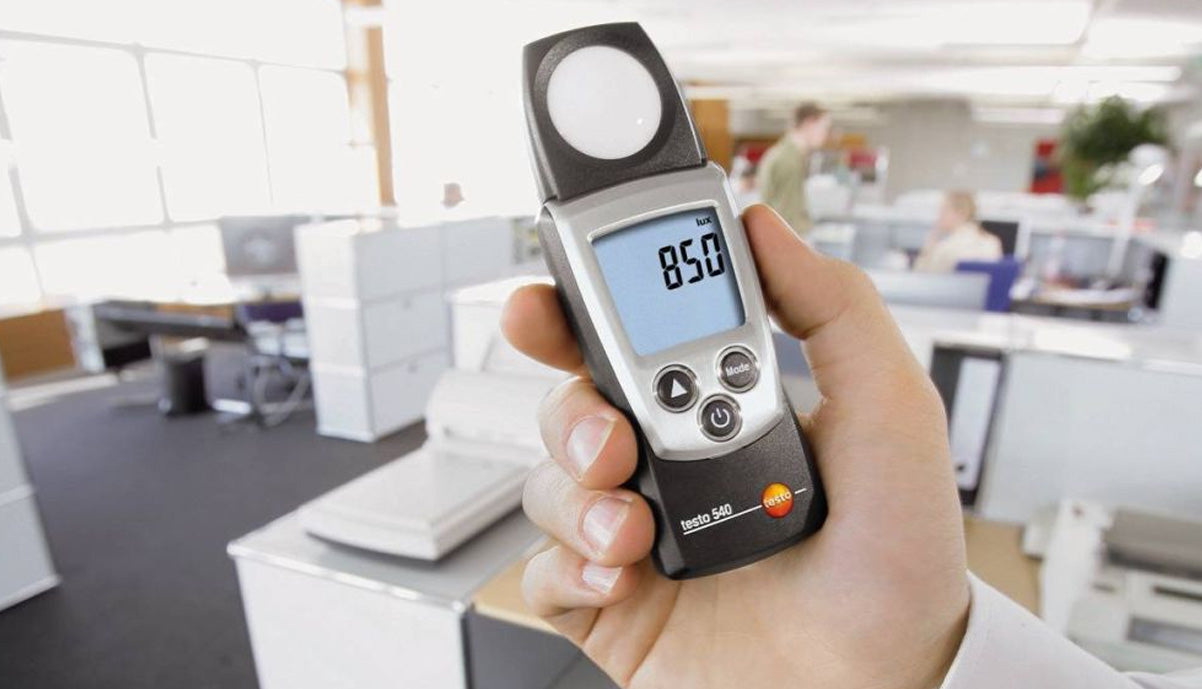
Lux meters are the unsung heroes of lighting measurement, playing a crucial role in various fields. In this comprehensive blog, we will illuminate the world of lux meters, their significance, and why finding the right one matters. Plus, we'll introduce you to Testo's top-notch lux meter products. Let's dive in!
What is a Lux Meter?
A Lux Meter, also known as an illuminance meter, is a handheld device used to measure illuminance, which is the amount of visible light that falls on a surface. It plays a crucial role in assessing and quantifying the brightness of light in various environments and applications.
The unit of measurement used by a Lux Meter is called "lux" (symbol: lx). Lux represents the amount of luminous flux (light energy) incident on a one-square-meter surface. In simpler terms, it measures how bright or intense the light is on a given surface area. Lux is particularly significant because it allows us to evaluate and ensure appropriate lighting levels in various settings.
In summary, a Lux Meter is a valuable instrument used to quantify light brightness in lux, ensuring adequate lighting levels are achieved in diverse applications, from photography and architecture to industrial settings and workplace safety.
What is a Lux Meter Used For?
A Lux Meter serves a wide range of applications across various fields due to its ability to measure and assess the intensity of light.
Here's a closer look at the diverse applications of Lux Meters and the importance of accurate lux measurements:
- Architecture and Interior Design:
In architecture and interior design, Lux Meters are used to ensure that buildings and spaces are adequately illuminated. This helps in creating comfortable and functional environments while adhering to design standards.
- Photography and Film Production:
Photographers and cinematographers rely on Lux Meters to determine the right lighting conditions for capturing high-quality images and videos. It ensures proper exposure and prevents over or underexposure.
- Workplace Safety:
Lux Meters are essential in industrial and construction settings to assess the lighting levels to ensure safe working conditions. Inadequate lighting can lead to accidents and decreased productivity.
- Horticulture and Agriculture:
In agriculture and horticulture, Lux Meters are used to optimise plant growth. They help determine the right amount of light required for photosynthesis and can be critical in greenhouse operations.
- Energy Efficiency:
Lux Meters play a role in energy-efficient lighting design. Measuring lux levels, businesses and facilities can ensure that lighting systems are optimized for energy savings without compromising productivity or safety.
- Museum and Art Conservation:
Museums use Lux Meters to control lighting conditions to protect valuable artworks, artefacts, and historical documents from damage due to excessive light exposure.
- Occupational Health and Safety:
Lux Meters are utilised to assess workplace ergonomics and ensure that workspaces are adequately illuminated to prevent eye strain and discomfort.
- Environmental Monitoring:
Environmental researchers use Lux Meters to study natural light conditions in ecosystems and assess the effects of light pollution on wildlife and plant life.
Accurate lux measurements are pivotal in ensuring human well-being, energy efficiency, and safety across these diverse fields.
How Do Lux Levels Work and What are Each Industry Standard Lux Levels?
Lux levels are a measure of brightness. They tell us how much light is available at a specific point and help ensure lighting conditions are appropriate for the intended purpose. In simpler terms, lux levels answer the question: "How well-lit is this area?"
Determining Lux Levels Based on the Type of Lighting Source:
The appropriate lux levels vary depending on the specific task, environment, and the type of lighting source used. Different activities and spaces require different lux levels to meet their objectives. Here are some common industry standard lux levels for various settings:
- Retail Stores: Showrooms: 750-1500 lux, Checkout areas: 500-1000 lux
- Educational Institutions: Classrooms: 300-750 lux, Libraries: 500-1000 lux
- Industrial Environments: Warehouses: 150-300 lux, Manufacturing areas: 300-750 lux
- Healthcare Facilities: Operating rooms: 1500-2000 lux, Patient rooms: 100-300 lux
- Outdoor Spaces: Street lighting: 10-50 lux, Sports fields: 300-1500 lux
- Specialised Areas: Art galleries: 150-1000 lux, Restaurants: 50-200 lux (varies with ambience)
These are general guidelines, and specific requirements may vary based on factors such as the nature of the task, the age of occupants, and any applicable regulations or standards. The type of lighting source used, whether it's natural daylight, incandescent, fluorescent, or LED, also affects the lux levels required.
Types of Lux Meters
Lux meters come in various types, each designed for specific purposes and with different features. Here are some common types of lux meters:
- Digital Lux Meter
- Analog Lux Meter
- Integrated Lux Meter
- Illuminance Probes
- Lux Meters with Data Logging
- Portable Lux Meters
How to Use a Lux Meter?
Using a lux meter is a straightforward process, and it involves measuring the illuminance (brightness) of a particular area.
Place the lux meter in the location where you want to measure illuminance. Ensure that the sensor area of the meter is facing the light source or the area you want to assess. Keep the sensor clean and free from obstructions. Allow the lux meter to stabilise for a moment to get a steady reading. Lighting conditions may fluctuate initially, so give it a few seconds to settle. Read the illuminance value displayed on the lux meter. Most digital lux meters provide readings in lux (lx). If you're using an analogue lux meter, note the position of the needle on the analogue scale.
Testo's Lux Meters
Meet Testo, a trusted name in lux meter manufacturing. We introduce you to a range of our top-quality lux meters:
- Universal IAQ Instrument - Testo 400 - Measures all IAQ-related parameters including illuminance
- Testo PocketLine Lux Meter - Designed for measuring lighting conditions in the workplace
- Testo 440 Lux Kit - IAQ measuring instrument and lux probe for measuring the illuminance in workplaces.
- Lux Probe Digital for Measuring Illuminance (Wired) - For measurements in workplaces, use the lux probe to measure illuminance.
- Testo 160 THL WiFi Data Logger with Integrated Sensors for Temperature, Humidity, Lux, and UV Radiation - Provides accurate information about the light conditions in a display cabinet or exhibition room.
Conclusion
As we conclude, we will recap the essential takeaways from our lux meter journey. Choosing the right lux meter is crucial for precision in your lighting measurements. Testo's lux meters offer the reliability and accuracy you need for all your lighting measurement requirements.

